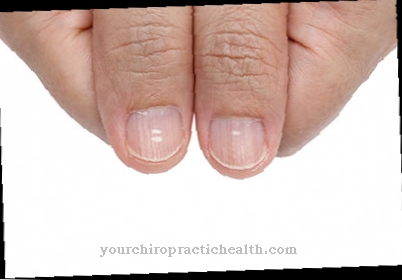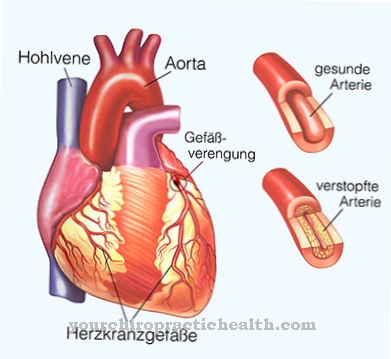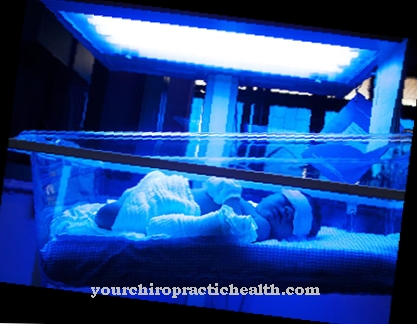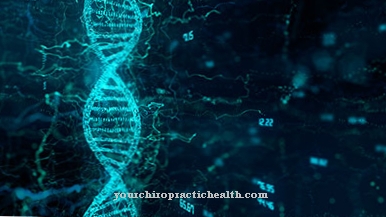The Clouston Syndrome is a type of ectodermal dysplasia. The cause is an autosomal dominant hereditary mutation. A causal treatment is not available.
What is Clouston Syndrome?

© あ ん こ ろ も ち (ankomando) - stock.adobe.com
Dysplasias are malformations in various tissues. The heterogeneous group of diseases of ectodermal dysplasia includes hereditary defects that are associated with malformations of structures from the outer cotyledon. The outer cotyledon of the embryo is called the ectoderm.
At the beginning of embryonic development, all cells of the embryo are omnipotent, which means that they can develop into any tissue through differentiation steps. The differentiation of the cells into the three cotyledons is an early step in embryonic development and converts the omnipotency of the cells into a multipotency. This means that the cells of the cotyledons can only become a certain range of tissues.
Those of the ectoderm become, for example, hair, nails, teeth and skin, including the sweat glands. In ectodermal dysplasia, the ectodermal cells develop incorrectly, resulting in malformations of the tissues mentioned. Ectodermal dysplasia is Clouston syndrome. The symptom complex is also called hidrotic ectodermal dysplasia or ectodermal dysplasia II designated.
It is a rare and congenital disease that is characterized by a triad of nail dystrophy, hair loss and increased corneal formation in the area of the palms. The spread is given with one to nine people affected per 100,000 people. It was first described in 1929. The Canadian doctor H. R. Clouston is considered to be the first to describe it.
causes
Clouston syndrome has genetic causes. Familial clustering has been observed in association with the syndrome. The complex of symptoms is therefore innate and is passed on in an autosomal dominant mode of inheritance. The cause of the multiple dysplasias is a genetic mutation. The location of the causal mutations has also been defined.
The patients suffer from mutations in the GJB6 gene, which is located at the gene locus 13q12. The affected gene takes over the coding for the so-called gap junction protein connexin-30 in the DNA. This is a transmembrane protein which, through the formation of gap junctions between neighboring cells, enables a direct exchange of different molecules up to sizes of around one kDa.
With a mutation in the GJB6 gene, the connexin-30 protein does not have a normal structure. It therefore does not perform its tasks adequately. The formation of the gap junctions is more difficult. Gap junctions are pore-forming complexes made of proteins that tightly connect the cells to their plasma membrane. Connexons usually consist of around six subunits and form a channel between the cells that is used for the exchange of ions and substances.
Due to the mutation of the Clouston syndrome, subunits of the connexin-30 proteins are swapped or not present. The channel formation is problematic due to the faulty protein structure, so that the exchange of substances between neighboring cells of the ectodermal tissue is disturbed.
Symptoms, ailments & signs
Patients with Clouston syndrome suffer from pronounced cornification of the palms of the hands. In most cases, corneal formation increases with age. The patient's hair is falling out. Moderate to severe hair loss occurs as early as infancy and affects all hairy parts of the body.
The main hair is usually sparse and brittle. The affected person's nails usually have multiple nail changes, such as dystrophy, paronychia or discoloration. The nail tissue is often thickened and grows slowly. Sometimes the patient's nails also fall off. Although the skin is affected by changes, the sweat glands are fully functional.
The patient is able to sweat to a normal extent. Tooth changes are usually not present. The severity of any changes can vary. The triad of symptoms of nail dystrophy, hair loss and corneal formation in the sense of hyperkeratosis of the palms is not always complete. For example, some patients lack palmoplantar hyperkeratosis.
However, hair loss and nail changes always occur. There is no impairment in everyday life. The life expectancy of those affected is not restricted either. As a consequence of the severe hair loss, in extreme cases psychological complaints arise as secondary diseases.
Diagnosis & course
Der Art makes a diagnosis of Clouston Syndrome based on clinical symptoms. The disease needs to be differentiated from other dysplasias of the ectoderm. A mutation detection by means of molecular genetic analysis is usually used to confirm the diagnosis. This proof is also possible before the birth. The prognosis for patients with the syndrome is relatively favorable. Impairments in everyday life are not to be expected.
Complications
Due to the Clouston syndrome, the patient usually suffers from severe hair loss and discomfort on the inner surface of the skin. These can show an increased formation on the cornea, which leads to unpleasant feelings and pain. Hair loss occurs at a young age and mostly affects all areas of the body that are usually covered with hair.
Discomfort on the nails is also common. These can discolor or even fail completely. Symptoms often lead to inferiority complexes or to feelings of insecurity in the patient, as the appearance is severely affected by Clouston syndrome. Children can be teased and bullied because of the symptoms.
A causal treatment of Clouston syndrome is not possible. For this reason, only the symptoms are treated. The patient and the parents receive psychological support and advice in order to avoid depression and other psychological complaints.
The complications on the skin can possibly be eliminated with the help of ointments, although there is no promise of success for this treatment. Life expectancy is not reduced by the Clouston syndrome, but everyday life is very difficult for the patient.
When should you go to the doctor?
In the case of Clouston syndrome, a doctor should be consulted if the patient experiences various skin complaints. In most cases, those affected suffer from a cornification disorder, which mainly affects the inner surfaces of the hands. Hair loss can also indicate Clouston syndrome and should therefore be examined. The hair falls out on different parts of the body.
The aesthetic complaints can lead to bullying or teasing, especially with children, so it is advisable to see a psychologist if you have psychological problems. A doctor should also be contacted if the nails fall out or break off. As a rule, a dermatologist should be consulted in the case of Clouston syndrome. They can diagnose the syndrome and initiate treatment.
The life expectancy of the person affected is not reduced and in most cases the disease progresses positively. Severe psychological complaints should also be treated in order to avoid further complications or depression. Early therapy is necessary, especially in children.
Doctors & therapists in your area
Treatment & Therapy
There is no cure for patients with Clouston Syndrome. Since the changes are based on a mutation, causal therapeutic steps are not available as long as gene therapy approaches do not reach the clinical phase. For this reason, only supportive symptomatic treatment of those affected can be carried out.
The individual symptoms can possibly be alleviated by administering medication. In extreme cases, those affected receive psychotherapeutic care. Especially during puberty, severe hair loss can cause psychological complaints. In supportive psychotherapy, patients can deal with uncertainties so that psychologically normal development is guaranteed.
Symptoms such as nail changes and corneal formation can be countered with podiatry and cosmetic treatments. Some nail changes may require ointment bandages. An established therapy for the symptoms does not yet exist, which means that the doctor may proceed differently from case to case or try a wide variety of therapeutic approaches. It can take a more or less long period of time until a suitable and successful therapy is found for the individual case.
Outlook & forecast
Clouston syndrome cannot be treated causally because it is a genetic disease. For this reason, the syndrome cannot be completely cured, although some symptoms can be alleviated.
Without treatment, the patients suffer from hair loss or a significantly increased development of the cornea. Psychological complaints can also arise from these aesthetic symptoms. Furthermore, the disease leads to changes in the teeth and nails. If these are not treated either, severe pain or restrictions in everyday life can occur. The symptoms usually worsen over time if no treatment is initiated.
Since causal therapy is not possible, only the symptoms of Clouston syndrome are treated. With the help of surgical interventions, many of the aesthetic complaints can be alleviated. In most cases, the patients are also required to have several interventions. Teeth and nails in particular must be treated at an early stage in order to avoid complications in the patient's adulthood. The syndrome does not have a negative impact on the life expectancy of the person affected, although the symptoms can appear for a lifetime.
prevention
So far, Clouston syndrome can only be prevented through genetic counseling during the family planning phase.
Aftercare
Since Clouston syndrome is a genetic disease that cannot be treated causally or completely, there are no direct options for follow-up care either. The individual complaints can be treated with various therapies, but the patient is dependent on lifelong treatment. In order to limit the symptoms as much as possible, regular visits to the doctor and various check-ups are necessary.
Different therapeutic approaches can possibly also be tried, since the Clouston syndrome has not yet been extensively researched. In many cases, the Clouston syndrome also leads to psychological complaints in those affected, which should be treated by a psychologist. The parents and relatives can also seek psychological treatment in order to avoid complications or psychological upsets.
Psychological treatment should be initiated at a young age, as Clouston syndrome often leads to bullying or teasing in children. Although the syndrome does not have a negative impact on life expectancy itself, it does significantly reduce the quality of life. Contact with other sufferers of the syndrome can possibly have a positive effect on the course and reveal new therapeutic approaches.
You can do that yourself
Clouston syndrome requires a medical diagnosis. The treatment options available depend on the extent to which the disease occurs and what side effects are observed.
Ailments such as the typical nail changes and the formation of calluses can be counteracted with the help of cosmetic and podiatric remedies. For nail changes, bandages with medicinal ointments or natural remedies such as arnica or aloe vera are ideal. Pain can also be countered both with classic medicines and with natural resources. Turmeric and St. John's wort, which can be used in the form of ointments or tinctures, have proven themselves.
Appropriate care products can be used to counteract hair loss. In severe cases, wearing a toupee or a medical hair transplant makes sense. In the case of severe skin changes or excessive hair loss, as occurs in the disease especially during puberty, therapeutic advice is sometimes advisable. Affected people sometimes suffer severely from Clouston syndrome and the social exclusion that is associated with it. The most important measure is therefore comprehensive medical advice and support from friends and family members.


.jpg)
























